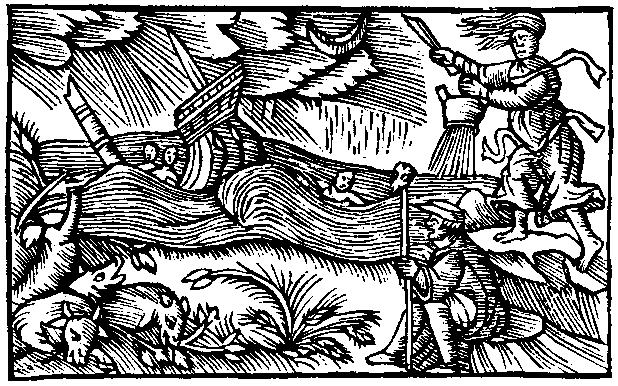
This woodcut depicts a storm being conjured. The figure with the sword or athame is perhaps trying to prevent the storm’s arrival on land, even as he is pouring water through the sieve in his other hand to raise the storm at sea.
The blizzard has begun here in NYC and the snow is blowing sideways! The ice and snow stung my face like sharp glass when I was out earlier this afternoon and it is only supposed to become more and more a Nor’easter-style blizzard as the night goes on. (But when did blizzards and storms start to be named? This is “Nemo,” I gather; aren’t hurricane names enough to keep track of?)
Weather has always been one of the most important contributors to human experience, especially in agricultural societies. Nowadays, we think nothing of checking what the weather will be like tomorrow or next week; not so long ago, we would not have known there was snow comiong until it started to fall. We would not know that it was a blizzard until it had — in fact — BECOME a blizzard or was nearly over. So knowing what the weather was going to be and having some small control over it was a major preoccupation in times past.
One of the most common ways to bring a rainstorm was to pour water through a sieve. Or sprinkling water with a handful of herbs could summon a downpour as well, as could burning heather and fern. A wind could be conjured by whistling, or playing a tune on a whistle (a whistle of rowan wood was especially effective). Swinging kelp in a clockwise direction and whistling woukd also attract the wind.
But whistling on a ship could bring on a dangerous storm. It was safer to buy a cord with the breezes and winds knotted into it. Such cords would typically have three (3) knots, each containing a breeze or stronger wind that could be released as needed. The sailor would release the most gentle breeze first and then release the others only if needed.
According to the book, Women Pirates and the Politics of the Jolly Roger by Ulrike Klausmann, Marion Meinzerin and Gabriel Kuhn [Black Rose Books, Montreal, 1997], the last European wind-seller was Bessy Miller, a resident of the Orkney Islands. Sea travelers were still paying her tribute in the nineteenth century.
To stop a storm, or at least prevent its damaging your house or fields, you can take your ritual dagger (athame) and swing it over your head, run toward the oncoming storm, and slice the air at the edge of your field with the athame, plunging the blade into the earth. This will slice the storm into pieces and divert it from your land.
